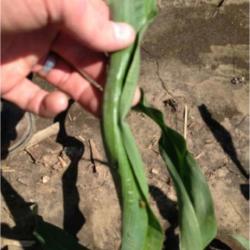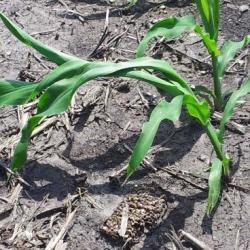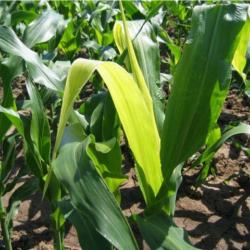Twisted Whorls in Corn
What Causes Twisted Whorls?

As the corn growing season transitions from cooler spring-like weather to the heat of summer, it is not uncommon to see fields with scattered or multiple plants whose leaves appear twisted or wrapped. This phenomena is known by several names including rapid growth syndrome, genetic wrap, onion leafing, buggy whipping among others. It often occurs when the corn plant transitions into the very rapid growth stage beginning at V5 (five leaves) through the late vegetative stages (V12-V14). The rapidly expanding plant leaves tend to remain rolled in the whorl and fail to unfurl as the growing point pushes out new vegetative material. Hybrid differences can be noted in the field. While some genetics appear more prone to twisting, differences in relative maturity, rate of plant growth and timing of temperature changes in the environment appear to explain much of the visual differences between hybrids in a field.

The main cause for twisted whorls is increase in temperature stimulating rapid growth in the plant. Some herbicide families can also create twisted whorls. Growth regulator herbicides such as 2,4-D or dicamba can cause leaf wrapping. An additional clue to look for when trying to diagnose the herbicide effects is by examining the brace roots for signs of root fusing or shortened roots (photo at right). This additional evidence may help define the cause. Herbicides from the chloroacetamide family on rare occasion will cause wrapped whorls and if it occurs, will typically be on plants smaller than V5.
What is the impact of Twisted Whorls?
Fortunately, twisted whorls tend to be a short lived phenomenon that is obvious for several days before the leaves unfurl. Observations comparing twisted and non-twisted plants have not shown noticeable differences in yield. Typically by tasseling it is very difficult to pick out those plants that were twisted earlier in the season.
In some fields with larger twisted plants or with very tight twisting you may see yellow “flag” leaves. Leaves will become yellow within the wrapped plant due to lack of sunlight penetrating the layers of leaves within the “twist”. When they release from the whorl the yellow color is noted but quickly recovers with exposure to sunlight.

Leaves that were twisted may have a wrinkled or bubbled appearance after they unwrap.
References:
- Kruger, G. 2012. Rapid Growth Syndrome Leads to Twisted Whorls. University of Nebraska Extension
- http://cropwatch.unl.edu/rapid-corn-syndrome-leads-twisted-whorls
- Elmore, R. 2008. Twisted Whorls, Integrated Crop Management Newsletter. Iowa State University Extension.
- http://crops.extension.iastate.edu/cropnews/2008/07/twisted-whorls
